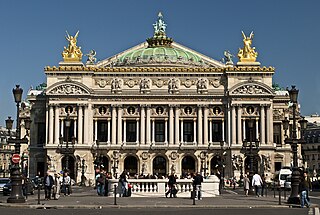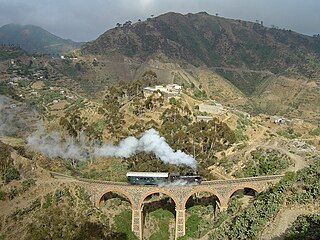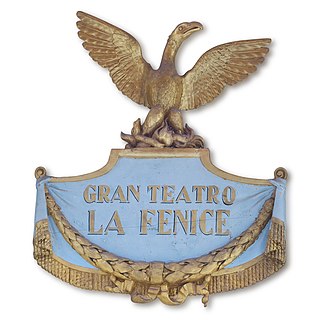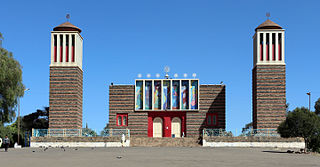

Asmara Theatre (Italian : Teatro di Asmara), also known as Asmara Opera, is a theatre in Asmara, Eritrea. It was constructed in 1918 following a design by the Italian engineer Odoardo Cavagnari, with later renovations in 1936. [1]


Asmara Theatre (Italian : Teatro di Asmara), also known as Asmara Opera, is a theatre in Asmara, Eritrea. It was constructed in 1918 following a design by the Italian engineer Odoardo Cavagnari, with later renovations in 1936. [1]


The building combines elements of Romanesque Revival and neoclassicism. The painting of the ceiling of the auditorium shows the tendencies of the Art Nouveau. Indeed, the roof has paintings by Saverio Fresa with dance images. It was one of the most famous buildings in Italian Asmara.
The building was erected on a hillside in Italian Asmara, [2] at the eastern end of the north side of today's Harriet Avenue (the old Corso Italia, later named Corso Mussolini and now the main road of Asmara) and at the corner of Beleza Street. This location made it possible to make the ascent to the Opera as a monumental staircase, which is circled on both sides by a shell-shaped fountain and a Renaissance-style loggia with Corinthian columns. The rest of the exterior of the building, especially the Beleza Street side facing, is castle-like, designed with battlements and towers. From the porch, it is possible to reach the foyer, which in turn gives access to the huge auditorium. This has, in addition to the parquet floor, three additional levels and can have 750 spectators. The stage is relatively small and does not have additional technical equipment.
In 1938 the international car race called the Asmara circuit was started exactly in front of the Opera building, on the Viale Roma (now called Sematat Avenue). [3]
The building was named Teatro Asmara until after being purchased by Eritrea and Ethiopia in 1952 from the Italian owners for far below the market value. After the independence of Eritrea in 1991/93, it was dispossessed and is now state-owned property again. [4] In the foyer, there is now a cafe, and in a side building, the headquarters of the national telephone company Eritel.
In Asmara Theatre were performed many "commedie" and opera works like those of Pirandello and music by Puccini and Verdi, with soprano from the best theatres in Italy: for example, in 1951 was performed "La Patente" of Pirandello and music of Chopin. [5]
After World War II and until the 1970s even international companies performed in the Asmara Theatre with famous "artistic & musical tours", like those of Renato Rascel and Renato Carosone. The theatre was still occasionally used in 2012.

Asmara, or Asmera, is the capital and most populous city of Eritrea, in the country's Central Region. It sits at an elevation of 2,325 metres (7,628 ft), making it the sixth highest capital in the world by altitude and the second highest capital in Africa. The city is located at the tip of an escarpment that is both the northwestern edge of the Eritrean Highlands and the Great Rift Valley in neighbouring Ethiopia. In 2017, the city was declared as a UNESCO World Heritage Site for its well-preserved modernist architecture. According to local traditions, the city was founded after four separate villages unified to live together peacefully after long periods of conflict. Asmara had long been overshadowed by nearby Debarwa, the residence of the Bahr Negash or the governor of the coastal province, however it still existed as a major settlement for over half a millennium and enjoyed some importance as it stood on the trade route to Massawa. Asmara first rose to prominence during the 20th century, when it became capital of Italian Eritrea. Under Italian rule the city of Asmara experienced rapid urbanization and modernization.

The Palais Garnier, also known as L'Opéra Garnier, is a historic 1,979-seat opera house at the Place de l'Opéra in the 9th arrondissement of Paris, France. It was built for the Paris Opera from 1861 to 1875 at the behest of Emperor Napoleon III. Initially referred to as le nouvel Opéra de Paris, it soon became known as the Palais Garnier, "in acknowledgment of its extraordinary opulence" and the architect Charles Garnier's plans and designs, which are representative of the Napoleon III style. It was the primary theatre of the Paris Opera and its associated Paris Opera Ballet until 1989, when a new opera house, the Opéra Bastille, opened at the Place de la Bastille. The company now uses the Palais Garnier mainly for ballet. The theatre has been a monument historique of France since 1923.

The Eritrean Railway is the only railway system in Eritrea. It was constructed between 1887 and 1932 during the Italian Eritrea colony and connects the port of Massawa with Asmara. Originally it also connected to Bishia. The line was partly damaged by warfare in subsequent decades, but was rebuilt in the 1990s. Vintage equipment is still used on the line.

Teatro La Fenice is a historic opera house in Venice, Italy. It is one of "the most famous and renowned landmarks in the history of Italian theatre" and in the history of opera as a whole. Especially in the 19th century, La Fenice became the site of many famous operatic premieres at which the works of several of the four major bel canto era composers—Rossini, Bellini, Donizetti, and Verdi—were performed.

The Real Teatro di San Carlo, as originally named by the Bourbon monarchy but today known simply as the Teatro (di) San Carlo, is a historic opera house in Naples, Italy, connected to the Royal Palace and adjacent to the Piazza del Plebiscito. It is the oldest continuously active venue for opera in the world, having opened in 1737, decades before either Milan's La Scala or Venice's La Fenice.

Renato Carosone was an Italian musician.

The Teatro dell'Opera di Roma is an opera house in Rome, Italy. Originally opened in November 1880 as the 2,212 seat Costanzi Theatre, it has undergone several changes of name as well modifications and improvements. The present house seats 1,560.

The Governor's Palace is the city hall of Asmara, Eritrea. It was built during the colonial period in the city centre, in an Italian Art Deco style.

The Museo Teatrale alla Scala is a theatrical museum and library attached to the Teatro alla Scala in Milan, Italy. Although it has a particular focus on the history of opera and of that opera house, its scope extends to Italian theatrical history in general, and includes displays relating, for example, to the commedia dell'arte and to the famous stage actress Eleonora Duse.

Eritrea, officially the State of Eritrea, is a country in the Horn of Africa region of Eastern Africa, with its capital and largest city being Asmara. It is bordered by Ethiopia in the south, Sudan in the west, and Djibouti in the southeast. The northeastern and eastern parts of Eritrea have an extensive coastline along the Red Sea. The nation has a total area of approximately 117,600 km2 (45,406 sq mi), and includes the Dahlak Archipelago and several of the Hanish Islands.

Italian Eritreans are Eritrean-born citizens who are fully or partially of Italian descent, whose ancestors were Italians who emigrated to Eritrea during the Italian diaspora, or Italian-born people in Eritrea.

Italian Eritrea was a colony of the Kingdom of Italy in the territory of present-day Eritrea. The first Italian establishment in the area was the purchase of Assab by the Rubattino Shipping Company in 1869, which came under government control in 1882. Occupation of Massawa in 1885 and the subsequent expansion of territory would gradually engulf the region and in 1889 the Ethiopian Empire recognized the Italian possession in the Treaty of Wuchale. In 1890 the Colony of Eritrea was officially founded.

Enda Mariam Cathedral is an Eritrean Orthodox church in Asmara, Eritrea. The cathedral is located on Arbate Asmara Street.

The Teatro Carcano is a theatre in Milan, Italy, located at 63 Corso di Porta Romana. Although now exclusively devoted to plays and dance, it served as an opera house for much of the 19th century and saw the premieres of several important operas. Completed in 1803, the theatre was commissioned by the Milanese aristocrat and theatre-lover Giuseppe Carcano and originally designed by Luigi Canonica. Over the succeeding two centuries it has undergone several restructurings and renovations and for a time in the mid-20th century functioned as a cinema.

The Teatro Flavio Vespasiano is the main theatre and opera house in Rieti. It was opened on 20 September 1893, after ten years of work and finishing touches; directed by architect Achille Sfondrini. It takes its name from the Roman emperor Titus Flavius Vespasian who was born in sabina.

Asmara circuit was a car race done in the main streets of Asmara, when it was a colony of the Kingdom of Italy. The Circuito was created in 1938 Italian Eritrea and was later done -with many interruptions- until 1972.

The Politeama Theatre is a theatre of Palermo. It is located in the central Piazza Ruggero Settimo and represents the second most important theatre of the city after the Teatro Massimo. It houses the Orchestra Sinfonica Siciliana.

Asmara, the capital of Eritrea, first rose to prominence in medieval and post-medieval times. Though it had long overshadowed by nearby Debarwa, the residence of the Bahr Negash or the governor of the coastal province, it still existed as a major settlement for over half a millennium and enjoyed some importance as it stood on the trade route to Massawa. During the 20th century it was a staging ground for Italian initiatives in East Africa, collateral of Britain's colonial politics, and the subject of the expansion of Ethiopia until 1993, when the sovereign state of Eritrea was established. Despite the passage of over seventy years, the city has remained mostly unchanged in structural design, likely influenced by its position as a UNESCO World Heritage Site.
The following is a timeline of the history of the city of Asmara, Eritrea. Asmara was under Italian colonial rule from 1889 until 1941.

The history of cinema in Eritrea dates back to the country's colonial rule under the Kingdom of Italy. In connection with the growth of Italian cinema in the 1930s, so too did the rise of cinema occur in Asmara, Eritrea. In 1937, Asmara's Opera was converted into a dual-use theatre and cinema. By the following year, Asmara had a total of nine movie theatres.